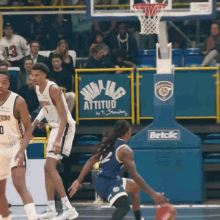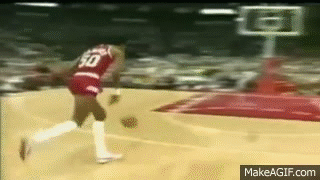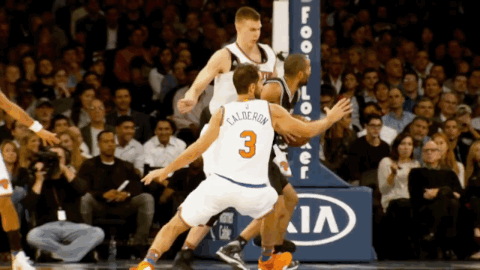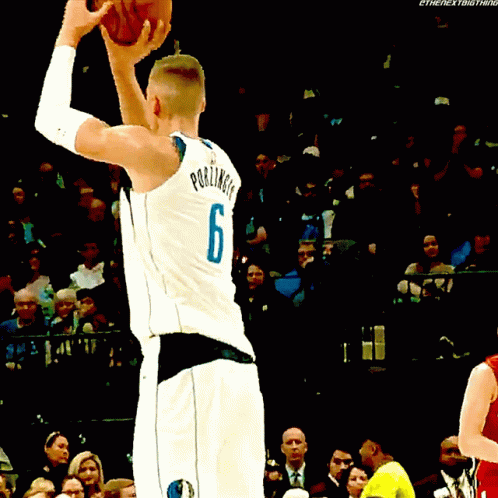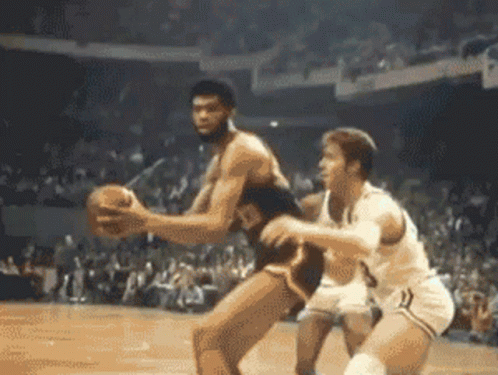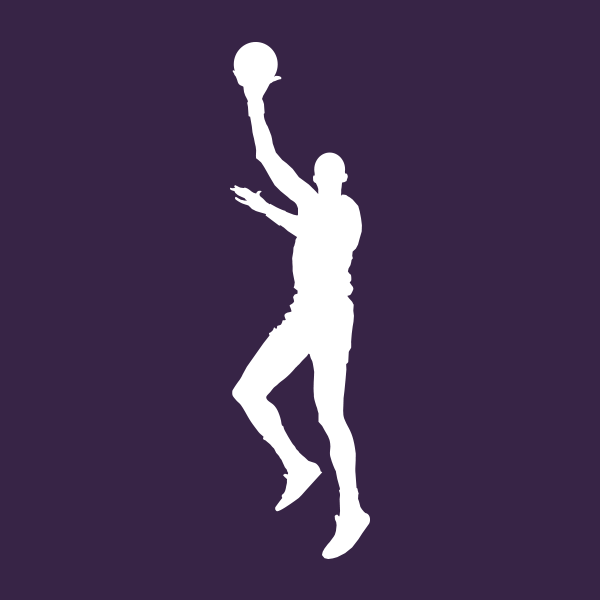Is There Anyone Like Victor Wembanyama?
There's no good comparison for Victor Wembanyama. But that didn't stop me from looking!
Victor Wembanyama, as I’m sure you all know, is the prized prospect of the 2023 NBA Draft class, now set to be a San Antonio Spur following the results of the 2023 NBA Lottery. With a rumored height of 7’4 or 7’5, and potentially an 8’ wingspan, Wemby is set to make history right away as an NBA player simply due to his dimensions. In this piece, I tried to identify NBA players of past and present that had similar characteristics to Wemby - the body type, the pedigree, the background, the skill level, even the personality. In this, we can imagine how Wemby himself will look in the NBA. Could Wemby add a consistent 3pt shot? How about a post hook game? What can he do to stand out in the fast break? Where is he best utilized as a defender? Basketball has been played for a long time, and as unique as Wemby is, there are always ways to project and speculate using similar circumstances.
Historical Comparisons
Frankly, finding potential comparisons for a guy like Wemby is way easier than your average prospect - you can start by eliminating everybody under 7’3, which eliminates almost every single human being to ever exist. To start I went to a Wikipedia page listing the tallest NBA players ever and took a look at two things - Height and Weight. Because not only is Wemby’s height a historical outlier, so to is his weight at that approximate height. As far as I can tell, Wemby weighs somewhere in the 210lb-230lb range, coming into the NBA at age 19. Compare that to other players 7’4 or above like:
Mark Eaton (290lb | 875 games)
Yao Ming (310lb | 481 games)
Gheorghe Muresan (315lb | 307 games)
Boban Marjanovic (290lb | 296 games and counting)
Priest Lauderdale (325lb | 74 games)
Tacko Fall (311lb | 37 games)
Peter John Ramos (290lb | 6 games)
Pavel Podkolzin (305lb | 6 games)
Sim Bhullar (359lb | 3 games)
It’s hard to imagine Wembanyama tacking on an additional 60+ lbs from this point on, so these folks are tough comparisons. While there is the obvious concern of strength that comes with a lack of weight, but one could speculate that having less weight especially on one’s upper body could lead to less force when landing from a jump or colliding with another player.
So now we have our sample of similarly-framed fellas, the ones who could hope to physically replicate Wemby in some sort of black market documentary down the line:
Manute Bol (7’7, 200lb | 625 games)
Shawn Bradley (7’6, 275lb** | 832 games)
Chuck Nevitt (7’5, 217lb | 155 games)
Rik Smits (7’4, 250lb | 867 games)
Ralph Sampson (7’4, 235lb | 456 games)
Swede Halbrook (7’3, 235lb | 143 games)
Keith Closs (7’3, 212lb | 130 games)
Kristaps Porzingis (7’3, 240lb | 402 games and counting)
**Note: Shawn Bradley was listed at 230lb entering the NBA
From this list, we can cross off Nevitt, Halbrook, Closs, and Bol as guys who were not high draft picks and had little expectations prior to joining the NBA. That leaves us with four great candidates for this exercise, all four of whom are worthy of discussion on their own - Shawn Bradley, Rik Smits, Ralph Sampson, and Kristaps Porzingis.
Shawn Bradley | 7’6 | 230lb → 275lb
2nd Overall Pick in 1993 NBA Draft (21 years old)
NBA Stats: 832 career games (23.5 minutes per game)
Per Game: 8.1 PTS | 6.3 REB (2.1 oreb) | 0.7 AST | 1.3 TOV | 2.5 BLK | 0.6 STL
Shooting Splits: 2PT: 2709/5896 (45.9%) | FT: 1322/1847 (71.6%) | 3PT: 4/39 (10.3%)
The Stormin’ Mormon was the pride of Utah back in the early 90’s; after racking up at 68-4 record in high school (along with two state championships), Shawn Bradley decided to stay at home in Utah to attend BYU. Having grown to 7’5 by his junior year of high school, Bradley had more control of his body than would be expected given his age, which helped him produce at a high level early on. At BYU, Bradley put up per game stats of 14.8PTS, 7.7REB, 1.2 AST, 2.3 TOV, and a remarkable 5.2BLK - that equals 177 total blocks, best for third most all-time for a freshman (Keith Closs at Central Connecticut and Hassan Whiteside at Marshall surpassed his average). Bradley also set an NCAA record with 14 blocked shots in a single game (since surpassed only once by Mickell Gladness, who swatted 16 shots for Alabama A&M).
In the NCAA Tournament, #10 BYU beat #7 Virginia 61-48, anchored by another record breaking performance by Shawn Bradley, who blocked 10 shots which was the most in a single tournament game up to that point. They lost the next game to Arizona 76-61 in a game Bradley only played 27 minutes and tallied only 10 points and 2 blocks due to foul trouble (he had three fouls in a four minute span, fouling out at the 5:39 mark of the 2nd). The disappointing loss marked the Stormin’ Mormon’s final appearance in Provo, as he served two years in Sydney, Australia as a missionary for the Latter-day Saints Church, in which Bradley was raised. In 1993, Bradley returned from his service and declared for the NBA Draft, where he was selected 2nd overall behind Chris Webber (and one pick ahead of Penny Hardaway).
However, his pro career was rather underwhelming. While Bradley did have a remarkable six seasons with 3+ blocks per game, he was only a consistent starter for a couple of years, and was traded twice in his first four seasons before finishing his career out as a part-time starter with Dallas. His only substantial playoff run was in 2000-01 with Dallas, when the team beat Utah in 5 games before falling to the Spurs in 5 games; Bradley averaged 25.6 minutes per game, putting up 6.4PTS, 7.1REB, and 3.0BLK in his run. Unlike the others on this list, Bradley was never much of a skilled big. He struggled to establish favorable post position, but didn’t have the faceup or jumper game to compensate like Smits, Sampson, and Porzingis. Instead, he spent his career doing the dirty work that big men of the 90’s were expected to do - he caught alley-oops, grabbed rebounds, and swatted shots on defense.
What makes Shawn Bradley a unique comparison for Wembanyama is his physical stature - Bradley is the only one on this list that gave me the same awestruck sensation of seeing Wemby on the floor for the first couple of times. Wemby is rumored to be as tall as 7’5 with up to an 8’ wingspan, and Bradley stands at 7’6 with a rumored 7’8 wingspan of his own. He could move with relative grace, and his coordination at his height wasn’t elite, but impressed me nonetheless. Bradley was a shot blocker in the mold of Mark Eaton, savants of the 80’s and 90’s style of standing in the paint and letting the ball come to you. Wembanyama won’t have the luxury of such a simple role, given the prominence of 3PT shooting at the big-man position these days. But Wemby would do well to study the shot blocking of Shawn Bradley, and we can use that film to attempt to imagine how this skill alters the geometry of the NBA court.
Rik Smits | 7’4 | 250lb
2nd Overall pick in the 1988 NBA Draft (Age 22)
NBA Stats: 867 career games ( 26.6 minutes per game)
Per Game: 14.8 PTS | 6.1 REB (1.8 oreb) | 1.4 AST | 1.8 TOV | 1.3 BLK | 0.4 STL
Shooting Splits: 2PT: 5298/10435 (50.8%) | FT: 2266/2932 (77.3%) | 3PT: 3/26 (11.5%)
The Dunking Dutchman is likely the most anonymous of the four folks listed in this analysis, as he is remembered neither as a bust nor as a generational star. Nor was he a highly touted recruit like Shawn Bradley or Ralph Sampson; in fact, when Smits wrote to US colleges seeking a spot on an NCAA roster, the only responses he received were from a DII school in Colorado, and a recruiter at LSU who suggested he look into the JuCo route. Smits ended up at Marist College, a tiny school that had only joined the DI ranks a few years prior, but his stellar play helped the Red Foxes make two NCAA Tournament appearances, and as a senior Smits’ stature grew to the point he one of the to prospects in the 1988 NBA Draft.
Fortunately, Smits was not selected #1 overall and summarily plunged into the ever-swirling sinkhole of a franchise that was the LA Clippers under Donald Sterling. Rather he landed in Indiana at age 22, right alongside budding star Reggie Miller in his age 23 season - both would go on to play their entire careers with the Pacers. Right away Smits made an impact, and was established as the starter for the prime of his career in Indy. His point totals steadily climbed as he progressed, though oddly he was never a devastating shot blocker despite his height - Smits’ career high in BPG for a season was 2.1 in his 2nd year, and after age 25 he never blocked more than 1.2 shots per game in a single season. Instead, Smits leaned into a heavier offensive role, scoring 40+ multiple times and tallying a USG% over 28% for four years straight (Ages 29-32). While he was never much of a long-range shooter, Smits excelled in the “high paint” area with his skilled hook shots and close jumpers that simply soared over the defense. With the level of touch he showed, and the rapid development he was able to make at Marist and in the pros, it’s easy to imagine Smits would have been an efficient spot-up threat similar to Kristaps Porzingis in the modern NBA.
Another impressive aspect of Rik Smits’ career was his durability and longevity for a player at his height. He played 4 years of college ball at Marist and then 12 NBA seasons, and only missed 82 regular seasons over that span. It is notable that he only averaged 26.6 minutes per game over his career, and never played more than 30.5 minutes per game in a given season. Smits was even able to reach the All-Star team at age 31, even then playing only 28.6 minutes per game that season. Eventually Smits retired at age 33, citing a series of health issues with his feet including nerve damage. It is worth noting that Rik Smits was not a prized athlete at an early age, and never had the same level of medical support and advice that modern big men receive. But Wemby would do well to take note of the career of ol’ Dutch - not only was he able to remain effective into his early thirty’s, but Smits actually peaked at a later age, sometime around 30 or 31. Wemby is skilled enough to excel into his 30’s, given he can maintain his body and avoid chronic luck-based injuries, which makes Rik Smits one of the best analogues for what Mr. Wemby can do on offense - just watch a couple clips of Smits in his heyday and you’ll instantly see how valuable it is to be able to simply shoot over everyone else.
Ralph Sampson | 7’4 | 200lb →235lb
1st Overall Pick in the 1983 NBA Draft (Age 23)
NBA Stats: 456 career games (29.8 minutes per game)
Per Game: 15.4 PTS | 8.8 REB (2.6 oreb) | 2.3 AST | 3.0 TOV | 1.6 BLK | 0.9 STL
Shooting Splits: 2PT: 2914/5954 (48.6%) | FT: 1181/1786 (66.1%) | 3PT: 10/58 (17.2%)
According to a news report I found on YouTube, Ralph Sampson was already 7’3 yet weighed only around 200lb in his senior year of high school in Virginia. In the end, he was officially listed at 7’4, and his weight ramped up to approximately 235lb. His frame is a great approximation of Wemby, although I don’t think he has quite the wingspan - if anything I’d expect Sampson to be more in the 7’4 - 7’6 range in that regard. Sampson is to this day one of the most heavily coveted recruits in NCAA basketball history, and lived up to the hype in his four years at Virginia where he collected awards and recognitions like they were Gen 1 Charizard cards.
3x Consensus All-ACC team
3x Consensus All-American team
3x ACC Player of the Year
3x Naismith Award winner
3x Rupp Trophy recipient
3x AP Player of the Year
2x John Wooden Award winner
And after not making the NCAA Tournament his freshman year, (though they did win the NIT tournament) Sampson led UVA to #1 seeds in the next three tournaments, though they only went as far as the Final Four during his tenure. Despite this, Sampson was as heralded as a prospect headed into the NBA Draft as he was prior to college; after a rollicking 14-68 record, the Houston Rockets had landed the #1 pick in 1983 and wasted no time establishing him as the focal point of their franchise. (An interesting note - Chuck Nevitt, a 7’5 gentleman mentioned earlier in this article, was also on the Rockets team…though Nevitt recorded only 64 minutes on the season. Suddenly the nickname Human Victory Cigar makes a whole lotta sense.) A year later, the Rockets landed the #1 pick again after a 29-53 record, delivering another generational big man to the coast in Hakeem Olajuwan. The next year, the Twin Towers led the Rockets to a 48-34 season, and by Sampson’s third year Houston was two games away from defeating the mighty Boston Celtics in the NBA Finals.
Instead, Larry Bird and his hall-of-fame teammates won the 1986 NBA Finals, and unfortunately Sampson was never able to return to the peak of the NBA Playoffs. The next year, Sampson had knee issues that kept him out for half the season, and despite making four straight all-star teams in his first four seasons, the Rockets decided to ship Sampson off to Golden State only a year and a half after making the NBA Finals. As heartless as the decision was, it is hard not to view it as the correct decision; Sampson had one more season at 61 games, but was never able to come close to a full season again. Ralph Sampson’s prime was over by age 26, and his playing career came to a close at age 31, after dealing with numerous nagging knee and back injuries.
What makes Ralph Sampson the ultimate predecessor to Victor Wembanyama is the similar flashes of brilliance with the ball in their hands, particularly when facing up. Opponents simply couldn’t reach his jump shot, and Sampson employed a deadly hook shot that evoked the image of Kareem’s signature skyhook. Ralph wasn’t a wary shooter either - if he had space anywhere out to 15ft, Sampson would shoot with absolutely no hesitation. While guys like Smits and Bradley flashed touch around the rim, Sampson wasn’t just a play finisher - he could run the fast break, make passes out of the post, and could even face-up and drive from the left block in remarkably controlled fashion. His defense was fundamentally sound, often letting smaller scorers simply shoot into his outstretched arms or jumping to erase shots at their apex rather than chasing the block at the source. Sampson was quick too, and very coordinated - his dunk reel is comprised of fast break dunks and high flying alley-oops rather than easy lobs up to the rim, and on more than a few occasions I was shocked to see how well he maintained a live dribble at his height. His footwook, too, was impeccable, and he always seemed to be the first one down the court on every fast break.
To be completely honest, I’m not sure even Wemby can pull off the same ease with which Sampson seemed to move, at times gliding through the air like Jordan or Drexler or Wilkins. However, Wemby can certainly aim to emulate Sampson’s attention to detail as an offensive player - his footwork and mechanics were very clean and consistent on his jumpers and post moves, although he wasn’t always the most efficient guy in the world, shooting 48.9% from 2 and a dismal 66.1% on FTs over his career. As far as actual jump shot mechanics though, Rik Smits and his career 77.3% shooting at the line may be better to emulate - at that height, it makes more sense to employ a set shot to ensure more lower body consistency. All in all though, Ralph Sampson seems to be the best historical comparison due to their very similar physical frames, offensive tendencies and movement patterns - not to mention the monumental amount of pressure both had given their size and skill at such an early age. I really enjoyed this NBC Sports news segment from 1979 during Ralph’s senior year of high school - the footage is phenomenal, and it really gives you a sense of how coveted his talents were already at age 17. It also gives you a sense of how ready Ralph was mentally to handle the pressure of his platform - he didn’t fail due to a lack of readiness or skill, it was simply a matter of his body failing him.
Kristaps Porzingis | 7’3, 230lb at time of draft
4th Overall Pick in the 2015 NBA Draft (Age 20)
NBA Stats: 402 career games and counting (31.1 minutes per game)
Per Game: 19.6 PTS | 7.9 REB (1.7 oreb) | 1.8 AST | 1.7 TOV | 1.8 BLK | 0.7 STL
Shooting Splits: 2PT: 2051/4106 (50.0%) | FT: 1563/1890 (82.7%) | 3PT: 737/2054 (35.9%)
Rumor of the 7’ Latvian kid who could shoot threes spread like wildfire leading up to the 2014 NBA Draft, and despite the lack of production or polish teams were considering drafting Porzingis late in the 1st. Instead, Porzingis pulled out of the draft and opted to play another year overseas, and from what I can tell Porzingis’ reported height went from 7’0 to 7’3 over the next year, which I’m sure played into the intrigue headed into the 2015 NBA Draft. Porzingis is unique in his origin as well as his draft pitch - he was viewed by his doubters as exclusively a jump shooter in his pre-draft years, and not surprisingly his toughness and physicality was questioned constantly. Porzingis is now listed at 240lb on basketball-reference.com and ESPN, which is a notable increase from his “generous” listing of 230lb by DraftExpress.com and a speculated 210-225lb prior to entering the NBA. His wingspan was estimated to be around 7’5, so another player on this list who didn’t have a significantly longer wingspan than standing height. Still Porzingis has been a constant rim deterrent, boasting a career average of 1.8 blocks per game that ranks near stalwarts like Yao Ming (1.89), Andrei Kirilenko (1.83), Brook Lopes (1.82), and Jermaine O’Neal (1.80); however he is nowhere near fellow 7’3+ guys Shawn Bradley (2.55), Manute Bol (3.34), and all-time leader Mark Eaton (3.50). Look only at active players and Porzingis ranks #4, behind only Anthony Davis (2.31), Myles Turner (2.28), Rudy Gobert (2.13), and Serge Ibaka (1.91) who I guess is still technically active.
Unfortunately like most athletes this tall, we have to talk about Porzingis’ injury history. Porzingis has only played over 60 games three times (his first two seasons and his most recent season) and most notably tore his ACL around midway through his third year, the 2017-18 season (his 22 year old season). In a cruel twist of fate, Porzingis made the All-Star team just a few weeks later, to this date his only appearance. But in that season, Kristaps put some moves on film that Wemby ought to be stuyding; at age 22 he put up per game stats of 22.7PTS, 6.6REB, 1.2AST, 0.8STL, 2.4BLK with a 31% Usage rate and 40% 3PT shooting on nearly 5 3PT attempts. His movement patterns on offense were closer to Smits and Sampson than Bradley, just in a spaced-out environment where he was encouraged to create at all three levels. Frankly I don’t think he has as much touch as Smits, and certainly not at the level of Sampson, but the time spent practicing his jump shot (and I’m sure modern coaching methods) make him a far more efficient scorer at the line and from 12+ feet than they could have dreamed to be.
Wemby and Porzingis have several similar strengths and weaknesses, one of which is their low post games - or lack thereof. While the Latvian legend proved his doubters wrong on many fronts, he certainly fell prey to their point that he would struggle as a defender given his lack of heft. It’s clear that Kristaps has the skill and agility to create on the block, but the lack of a signature shot and the inability to physically move defenders leaves him with inefficient options on the interior. That being said, I want to harp again on just how impressive Porzingis was as a shooter, even coming into the NBA - his catch-and-shoot form is tight, clean, and incredibly repeatable. His power comes from his lower body, using more of a set shot than a guy like Ralph Sampson who would fully extend. Wemby has certainly proven to be a more creative shooter, but his mechanics are not quite as ironed out, and he isn’t comfortable enough consistently shooting when he’s open off the catch. I would say this is where Wemby plays more like a wing/forward than a big man - he likes to play with his food a little bit, put the ball on the ground and try to outmaneuver anyone in his way. Whereas Porzingis fit right into the role of a big man that shoots & dunks - there’s a reason Kevin Durant coined the term “Unicorn” as a descriptor for the unique game that Kristaps brought to the league. Nowadays big men like Brook Lopez and Jaren Jackson Jr have adopted the role and have excelled even more as defenders - but he and KAT may be the most consistently dangerous big-man 3PT shooters in the current NBA.
I think there is one other name we must mention when discussing Victor Wembanyama - the first great “can’t-miss” prospect of basketball, as well as the greatest big man in NBA history, Kareem Abdul-Jabbar. While Kareem is only a measly 7’2, he seems to have a wingspan closer to 7’5 and certainly left a legacy as probably the most skilled big man of all time. While he was not in an era where a man of his size would be permitted to take jump shots, Kareem literally invented the most unstoppable move in NBA history, a move that has never been replicated in half a century of its existence, the unblockable skyhook.
Kareem Abdul-Jabbar
1st Overall Pick in the 1969 NBA Draft (Age 22)
NBA Stats: 1560 (36.8 minutes per game)
Per Game: 24.6 PTS | 11.2 REB (2.4 oreb) | 3.6 AST | 2.7 TOV | 2.6 BLK | 0.9 STL
Shooting Splits: 2PT: 15836/28289 (56.0%) | FT: 6712/9304 (72.1%) | 3PT: 1/18 (5.6%)
While we all know how great Kareem was as a scorer (hence the whole All-Time Scoring leader thing that LeBron just snatched last season), his shot blocking acumen is underappreciated - blocks weren’t even tracked until his fifth NBA season, yet he averaged over 3 blocks per game in 7 straight seasons, including two seasons over 4 blocks per game. He also maxed out at 16.9 rebounds per game back in 1975-76, his first year as a Laker.
Kareem was an unbelievable player who showed it all - regular season production, awards and recognitions, SIX championship rings. But I think one of the greatest aspects of Kareem’s legacy is his longevity - 1500+ career games, 57000+ career minutes, 8800+ career playoff minutes. Kareem played four years at UCLA, played his first NBA season as a 22 year old, and still managed to play at a high level for TWENTY YEARS.
Wembanyama has prioritized proper maintenance of his body since a young age; folks have noted his meticulous pre-game stretching routing, part of which involves him walking on his fingertips and toes - surely a fascinating sight. But perhaps he could learn something from the great Kareem Abdul-Jabbar about how to care for himself both physically and mentally, how to handle the pressure of being such a massive figure in the NBA landscape and all the expectations that have been placed on his shoulders over the past year. Kareem famously practiced yoga, meditation, and martial arts early in his playing career and throughout his life. He was also an activist in every sense of the word - he actively supported causes important to him, like the empowerment of Black people and combatting Islamophobia within the US. Even now, you can find Kareem on this very website - and unsurprisingly, his work has very little to do with the trivialities of sports and much more to do with the injustices in our society. Check it out here:
In Conclusion
Despite the intriguing similarities and comparable skillsets, it is clear as ever that there has never been a prospect like Victor Wembanyama. He moves with grace and balance, makes decisions with ease, and has a sense of coordination that makes him a threat all over the court no matter the context. He runs the fast break like Ralph Sampson, shoots jumpers like Kristaps Porzingis, blocks shots like Shawn Bradley, and has touch like Rik Smits - plus the indominable spirit and all around game of Kareem Abdul-Jabbar. Out of the infinite number of possibilities that lie ahead for Wemby, so so many of them result in him being a great basketball player. Can he live up to the reputation that now precedes him? Kareem, Wilt, Shaq, Hakeem, Russell, Moses…can Wembanyama control the court like the great big men before him? Learning from the legends that preceded him will help Wemby build a legacy of his own, one truly different than anyone else we’ve ever seen.





